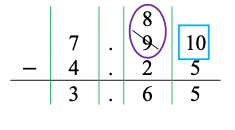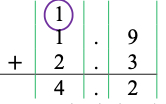General Information
Benchmark Instructional Guide
Connecting Benchmarks/Horizontal Alignment
Terms from the K-12 Glossary
- Equation
- Expression
Vertical Alignment
Previous Benchmarks
Next Benchmarks
Purpose and Instructional Strategies
The purpose of this benchmark is for students to add and subtract multi-digit numbers with decimals to the thousandths with procedural fluency. In grade 4 (MA.4.NSO.2.7), students explored the addition and subtraction of multi-digit numbers with decimals to hundredths using money and manipulatives. In grade 6, students add and subtract positive fractions with procedural fluency.- To demonstrate procedural fluency, students may choose a standard algorithm that works best for them and demonstrates their procedural fluency. A standard algorithm is a method that is efficient and accurate (MTR.3.1).
- When students use a standard algorithm, they should be able to justify why it works conceptually. Teachers can expect students to demonstrate how their algorithm works, for example, by comparing it to another method for addition and subtraction (MTR.6.1).
- Along with using a standard algorithm, students should estimate reasonable solutions before solving. Estimation helps students anticipate possible answers and evaluate whether their solutions make sense after solving.
Common Misconceptions or Errors
- Students can make computational errors while using standard algorithms when they cannot reason why their algorithms work. In addition, they can struggle to determine where or why that computational mistake occurred because they did not estimate reasonable values for intermediate outcomes as well as for the final outcome. During instruction, teachers should expect students to justify their work while using their chosen algorithms and engage in error analysis activities to connect their understanding to the algorithm.
Strategies to Support Tiered Instruction
- Instruction includes estimating reasonable values for sums and differences when adding and subtracting decimals to the hundredths.
- For example, students make reasonable estimates for the sum of 6.32 + 2.84. Instruction includes stating, “Before using an algorithm, we will estimate the sum to make sure that we are using the algorithm correctly and our answer is reasonable. I will use my understanding of rounding decimals to estimate my sum. The addend of 6.32 rounds to 6 when rounded to the nearest whole number and reasonable estimate for my sum would be 9 because 6 + 3 = 9.”
- For example, students make reasonable estimates for the difference of 7.9 − 4.25. Instruction includes stating, “Before using an algorithm, we will estimate the difference to make sure that we are using the algorithm correctly and our answer is reasonable. I will use my understanding of rounding decimals to estimate my difference. The minuend of 7.9 rounds to 8 when rounded to the nearest whole number and the subtrahend 4.25 rounds to 4 when rounded to the nearest whole number. A reasonable estimate for my difference would be 4 because 8 − 4 = 4.” the addend 2.84 rounds to 3 when rounded to the nearest whole number.
- Instruction includes explaining and justifying mathematical reasoning while using an algorithm to add and subtract decimals to the hundredths. Instruction also includes determining if an algorithm was used correctly by analyzing any errors made and reviewing the reasonableness of solutions.
- For example, students use a standard algorithm to determine 6.32 + 2.84 and explain their thinking using a place value understanding. Instruction includes stating, “Begin by lining up the decimal points and place values for each addend. Next, add in hundredths place. 2 hundredths plus 4 hundredths are 6 hundredths. Because the total number of hundredths is less than 10 hundredths it is not necessary to regroup. Next, add in the tenths place. 3 tenths plus 8 tenths are 11 tenths. Because I have more than 10 tenths it is necessary to regroup the 10 tenths to make one whole. After composing a group of 10 tenths there is 1 tenth remaining. Finally, add 6 ones plus 2 ones and the 1 whole that was regrouped from the tenths place. The sum is 9.16. Our sum of 9.16 is close to our estimate of 9, this helps us determine that our answer is reasonable.”

- For example, students use a standard algorithm to determine 7.9 − 4.25 and explain their thinking using place value understanding. The teacher reminds students that 7.9 is equivalent to 7.90 and uses a decimal grid to show the equivalency of 0.9 and 0.90 if needed. Instruction includes stating, “Begin by lining up the decimal points and place values. Next, subtract 4.25 starting in the hundredths place. There are not enough hundredths to subtract 5 hundredths from 0 hundredths. It is necessary to decompose one tenth into 10 hundredths. Now there are 10 hundredths, and there is enough to subtract 5 hundredths. 10 hundredths − 5 hundredths = 5 hundredths. Then, subtract the tenths: 8 tenths − 2 tenths = 6 tenths. Finally, subtract the ones: 7 ones − 4 ones = 3 ones. The difference is 3.65. Our difference of 3.65 is close to our estimate of 4, this helps us determine that our answer is reasonable.”

- For example, students use a standard algorithm to determine 1.9 + 2.3 and explain their thinking using a place value understanding. Instruction includes stating, “Begin by lining up the decimal points and place values for each addend. Next, add in tenths place. 9 tenths plus 3 tenths are 12 tenths. Because I have more than 10 tenths it is necessary to regroup the 10 tenths to make one whole. After composing a group of 10 tenths there are 2 tenths remaining. Finally, add 1 one plus 2 ones and the 1 whole that was regrouped from the tenths place. The sum is 4.2. Our sum of 4.2 is close to our estimate of 4, this helps us determine that our answer is reasonable.”

- For example, students use a standard algorithm to determine 5.2 − 3.8 and explain their thinking using place value disks and their understanding of place value. Instruction includes stating, “Begin by lining up the decimal points and place values. Next, subtract 3.8 starting in the tenths place. There are not enough tenths to subtract 8 tenths from 2 tenths. It is necessary to decompose one whole into 10 tenths. Now there are a total of 12 tenths, and there are enough to subtract 8 tenths. 12 tenths – 8 tenths = 4 tenths. Finally, subtract the ones: 4 ones – 3 ones = 1 one. The difference is 1.4. Our difference of 1.4 is close to our estimate of 1, this helps us determine that our answer is reasonable.”

- Instruction includes the use of place value columns to support place value understanding when using an algorithm to add and subtract decimals.
Instructional Tasks
Instructional Task 1 (MTR.3.1)
Use a standard algorithm to find the difference of eight hundred two and forty - Six thousandths and three hundred and nine tenths. Explain how you use your algorithm to subtract.
Instructional Items
Instructional Item 1
Find the sum and difference of 8.72 and 3.032.*The strategies, tasks and items included in the B1G-M are examples and should not be considered comprehensive.
